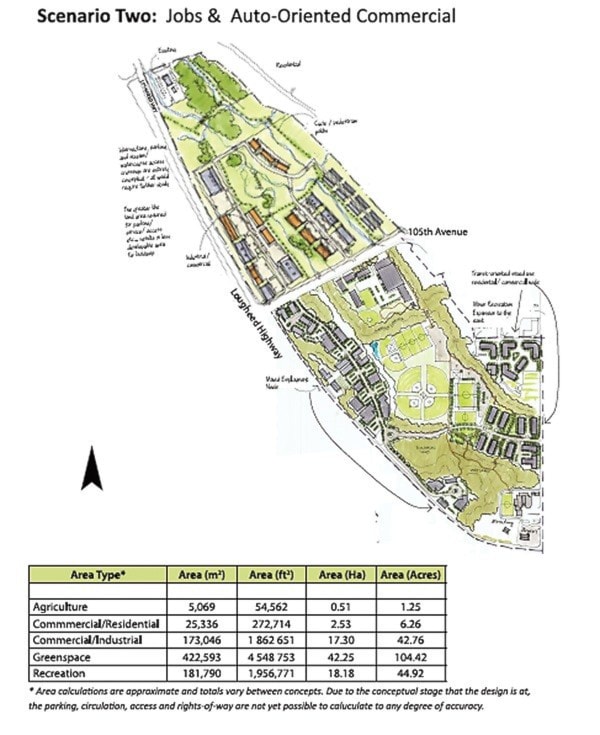Maple Ridge council has rejected its consultant’s advice and is focusing on two scenarios that call for the most intensive development of Albion flats.
The decision came at its Tuesday meeting, to be followed by more discussion on Monday, when council hammers out exactly what it wants to see for the farmland on Lougheed Highway and 105th Avenue.
In his report to council, consultant Mark Holland recommends all four scenarios that came out of the brainstorming and public meeting sessions last fall be sent to the Agricultural Land Commission for comment.
Scenarios 2 and 4 call for development on both sides of 105th Avenue and a minimum of 1.7-million sq. feet of commercial/industrial space, while Scenarios 1 and 3 call for less intense development, emphasizing recreation and leaving most of the west side as farmland.
“I do think there’s a lot more conversation we can have with the public,” said Coun. Cheryl Ashlie.
She pointed out that the ALC could favour an option calling for heavy recreational use, which the district couldn’t afford anyways.
She favoured the idea of only sending two scenarios, as long as some elements from the other two could be considered.
Council hired top planners to sketch out options for the area after getting community input, but it’s council’s job to decide what to do with it, added Mayor Ernie Daykin.
“We’ve been working on this a while,” he added. “It’s quite clear, folks want to see more shopping options.”
Council could settle on a blend of all scenarios, then have an open house to get public comment before forwarding a scenario to the ALC for comment on what portions could be excluded from the agricultural reserve for development.
A formal application to exclude the land would come later.
Ashlie and Daykin were supported by Couns. Al Hogarth, Judy Dueck and Mike Morden in focusing on the development scenarios.
Dueck said only one scenario should be sent forward and didn’t believe development in Albion flats would hurt the town centre.
“I believe quite the opposite actually.” More shopping will keep people from having to leave Maple Ridge and there’s enough demand in Maple Ridge to support both areas, she said.
Hogarth said Maple Ridge has to be more clear in what it sends to the commission. “I think we can come up with something extremely unique.”
With climate change making weather increasingly unpredictable, Hogarth questioned if the fields in the flats are still suitable for farming. “I think we need to do our job. That’s what the public expects from us.”
That doesn’t mean spending more money for further studies, he added.
Coun. Linda King and Craig Speirs were frustrated by the decision. No option would be excluded by sending all four scenarios, Speirs pointed out.
“Everything is included.”
Getting the commission’s comment on all four options can help the district avoid the pitfalls it encountered in 2010, when it sent an exclusion application for the Pelton tree nursery lands on 203rd Street, an application that was turned down by the ALC, he pointed out.
“I would like to get this off the table.”
Speirs questioned how much more public opinion the district needs given the brainstorming sessions and meetings that took place last summer and fall.
“If we send forward one proposal and that proposal is rejected, we are hooped for several years,” said King.
“We may not like it, but the Agricultural Land Commission is more powerful than we are, in so far as agricultural land is concerned.
“And they have the power to say no and they have said no in the past.”
She found her colleagues’ decision “incomprehensible.”
“I’m just completely puzzled and mystified as to why we’re proceeding the way we are.”
She said council now has a chance to hear what the land commission has to say, then choose the option that’s most likely to receive ALC approval.
Holland said previously that developing both sides of 105th Avenue could effect the downtown’s viability. According to one of the background reports, there only would be demand for 303,000 sq. feet of commercial space by 2017 – assuming mall projects planned in Pitt Meadows and on Kwantlen First Nations land east on Lougheed Highway don’t proceed.
However, both Scenarios 2 and 4 favoured by council call for at least 1.7 million sq. feet of commercial/industrial development.
Daykin said large format stores help keep shoppers at home. “People are leaving town to shop now.”
In his covering letter to council, Holland said the community and interest groups generally supported developing the east side of 105th Avenue, while there was disagreement on what to do with the west side of 105th Avenue.
“Forwarding all scenarios will accurately reflect what was heard from all groups at the public forum and will enhance the usefulness of feedback from the ALC.”
Morden called for a full business case for whatever the district decides. “We best have a case that shows what that looks like and what the offset is.”
SmartCentres representative Nathan Hildebrandt was happy with the outcome.
“We think they made the right decision.” The company owns several acres on the west side of 105th Avenue, along Lougheed Highway.
Those scenarios will allow the landowners to make their case for developing the land and to address agricultural concerns.
“The land owners have to come up with that story, that justification,” he said.
But Daykin said landowners have had their say during the consultations last fall. “It’s council’s discussion.”
Council watcher and candidate for next election, John MacKenzie was disappointed, however.
All scenarios should be sent because the commission will make the final decision anyways, he said Wednesday.
“The citizens better start getting involved in this issue.”
